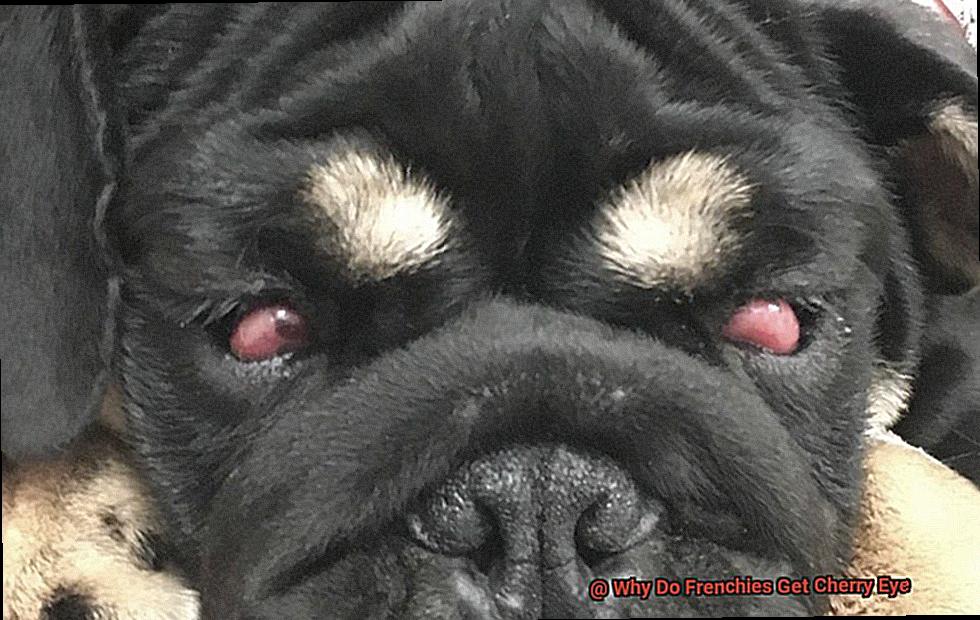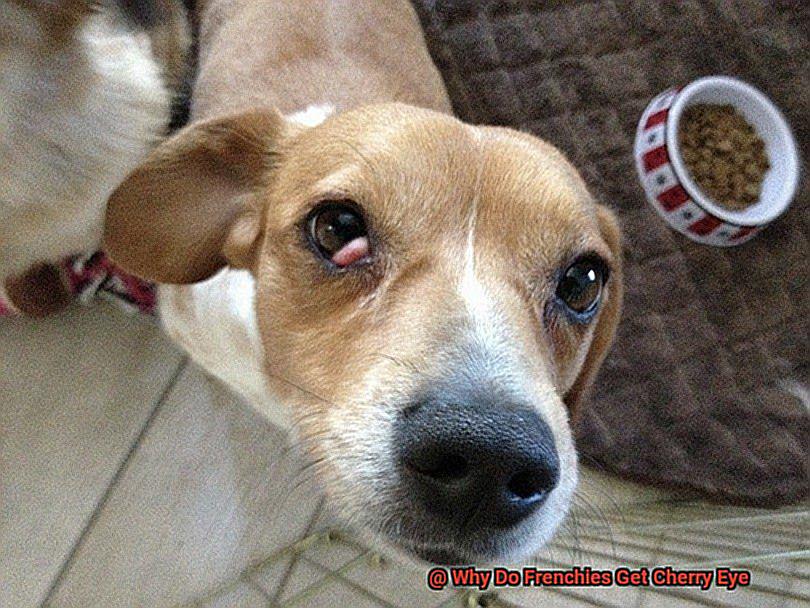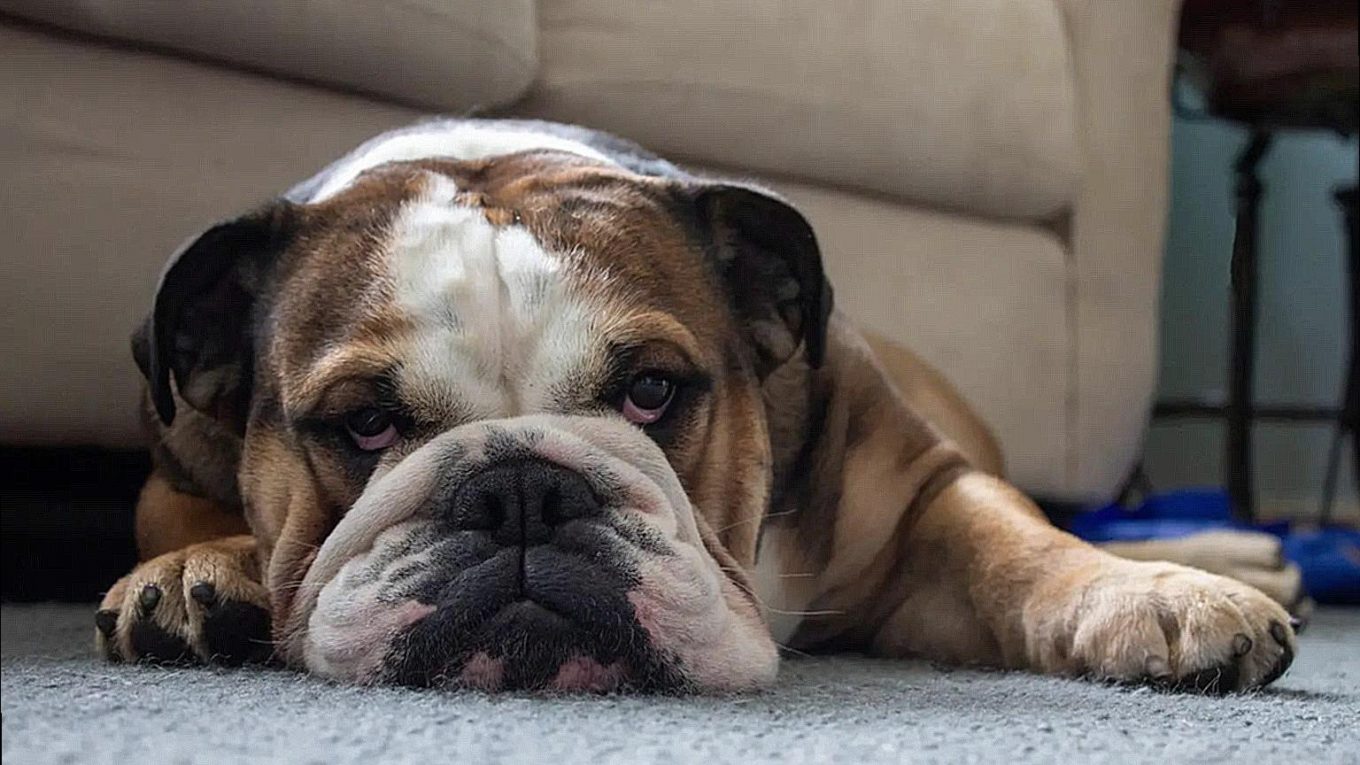Why Do Frenchies Get Cherry Eye?
With their smushy faces and playful personalities, it’s no wonder they’ve become such a popular breed. But along with their charm comes a common condition that may have you scratching your head (or rather, your Frenchie’s eye).
That’s right, we’re talking about cherry eye. If you’re a fellow Frenchie parent, you’ve probably heard of it before.
But what exactly is this “cherry eye” and why does it seem to target our four-legged friends? As a veterinarian with experience in treating this issue, I’m here to break it down for you.
Don’t worry, I promise it won’t be as intimidating as it sounds.
Why Do Frenchies Get Cherry Eye?
Contents
- 1 Why Do Frenchies Get Cherry Eye?
- 2 The Genetics Behind Cherry Eye in Frenchies
- 3 How the Physical Characteristics of Frenchies Can Contribute to Cherry Eye
- 4 Other Factors That May Trigger Cherry Eye in French Bulldogs
- 5 Potential Complications of Untreated Cherry Eye in Frenchies
- 6 Treatment Options for Cherry Eye in French Bulldogs
- 7 Preventing Cherry Eye in Your Frenchie: Tips and Strategies
- 7.1 Firstly, let’s talk about what cherry eye is and why it happens. Cherry eye occurs when the gland that produces tears becomes inflamed and protrudes from the inner corner of the eye. While genetics can play a role, there are other factors that can increase the risk of your Frenchie developing this condition. These include age, underlying health issues, and environmental triggers.
- 7.2 Keeping your Frenchie’s living environment clean and free of potential allergens is also crucial in preventing cherry eye. Dust, pollen, and mold can all trigger eye irritation and inflammation, so be sure to vacuum and dust regularly and keep your Frenchie away from areas with high levels of these allergens.
- 8 Conclusion
As much as we love our adorable flat-faced pups, they unfortunately have a predisposition to developing certain health issues. One common condition that affects Frenchies is cherry eye, also known as “bulldog eye” or “protruding third eyelid.” In this blog post, we’ll dive into the potential causes and risk factors of cherry eye in French Bulldogs to help you better understand this condition and how to prevent it.

What is Cherry Eye?
First things first, let’s define what cherry eye is and how it affects our furry friends. Cherry eye occurs when the gland in the third eyelid, responsible for producing tears and protecting the eye, becomes inflamed and prolapses. The prolapsed gland appears as a red or pink mass in the corner of the eye, resembling a cherry (hence the name “cherry eye”). While it may look concerning and unsightly, it is not painful for your Frenchie.
Causes of Cherry Eye in French Bulldogs
The exact cause of cherry eye in French Bulldogs is still unknown. However, it is believed to be a genetic predisposition. This means that certain breeds, such as Frenchies, are more prone to developing cherry eye due to their genetic makeup. Breeding dogs with a history of cherry eye increases the chances of their offspring developing this condition.
Apart from genetics, other potential factors that may contribute to cherry eye include allergies, infections, and trauma to the eye. Some experts also suggest that environmental factors like dust and pollution can irritate the third eyelid gland and lead to inflammation.
Risk Factors for Cherry Eye in French Bulldogs
While any Frenchie can develop cherry eye, there are certain risk factors that make them more susceptible to this condition. These include:
- Breed: French Bulldogs are one of the breeds most commonly affected by cherry eye. Other breeds that are prone to this condition include English Bulldogs, Pugs, and Cocker Spaniels.
- Shallow eye sockets: Frenchies have shallow eye sockets, which make it easier for the gland to slip out of place and become inflamed.
- Brachycephalic features: The shape and position of the eyes in brachycephalic breeds like Frenchies can also put pressure on the gland, making it more likely to prolapse.
The Genetics Behind Cherry Eye in Frenchies
We all know how much we adore our squishy-faced friends and want the best for them. But as much as we love them, we also know that they are prone to certain health issues, including cherry eye. So, what exactly is cherry eye and why do Frenchies seem to be more susceptible to it? Let’s dive in and explore the genetics behind this common condition.
First things first, what is cherry eye? Well, it’s not as delicious as it sounds. Cherry eye is when the third eyelid gland, also known as the nictitating membrane, prolapses or slips out of its normal position, causing a reddish lump in the corner of your Frenchie’s eye. While this can happen in any breed, it is more commonly seen in brachycephalic breeds like Frenchies due to their unique facial structure and genetics.
But don’t worry, studies have shown that there is a hereditary component to cherry eye in French Bulldogs. This means that the condition can be passed down from parents to offspring. In fact, a study published in the Journal of Small Animal Practice found that certain lines or families of French Bulldogs were more prone to developing cherry eye, suggesting a genetic predisposition.
So, what specific genetic factors contribute to cherry eye in Frenchies? One of the main culprits is a weak attachment of the third eyelid gland to the surrounding tissue. This makes it easier for the gland to prolapse and can be inherited from the parents. Think of it like a loose button on your favorite shirt – eventually, it’s going to pop off. Similarly, if your Frenchie has a weak attachment of their third eyelid gland, it’s more likely to slip out of place.
But wait, there’s more. It turns out that certain genes related to collagen production may also play a role in the development of cherry eye in French Bulldogs. Collagen is an important structural protein that helps maintain the integrity of tissues such as the third eyelid gland. So, if your Frenchie has a genetic predisposition for lower collagen production, this can increase their chances of developing cherry eye.
How the Physical Characteristics of Frenchies Can Contribute to Cherry Eye
As a French Bulldog owner, you may have noticed that your furry companion has large, expressive eyes and a short snout. While these physical traits make our Frenchies undeniably adorable, they can also make them more prone to certain health issues. One of these concerns is cherry eye, a condition where the third eyelid gland slips out of place. In this blog post, we’ll explore how the physical characteristics of French Bulldogs can contribute to this condition and what steps you can take to prevent it.
Short Snout and Shallow Eye Sockets
French Bulldogs are known for their short snouts and shallow eye sockets. While these features give them their unique appearance, they can also be a contributing factor to cherry eye. The shallow eye sockets make it difficult for their tear ducts to properly drain, leading to a buildup of excess tears. These tears can irritate the third eyelid, causing inflammation and eventually leading to cherry eye.
Large, Bulging Eyes
Another physical characteristic that puts French Bulldogs at a higher risk for cherry eye is their large, bulging eyes. The third eyelid in Frenchies is larger compared to other dog breeds, making it more susceptible to prolapse or slipping out of place. This can happen due to trauma or even just from rubbing their eyes too hard.
Genetics
In some cases, cherry eye in French Bulldogs may be caused by genetics. If a Frenchie’s parents or siblings have experienced cherry eye, there is a higher chance that they may develop it as well. This is because certain genetic factors, such as weak gland attachments and lower collagen production, can increase the likelihood of this condition.
Preventative Measures

So what can French Bulldog owners do to prevent cherry eye? Regular monitoring and proper grooming are key. Check your Frenchie’s eyes regularly for any signs of irritation or inflammation. Keep their eye area clean, and gently wipe away any excess tears or debris. If you notice any redness or swelling, consult your veterinarian for proper treatment.
Other Factors That May Trigger Cherry Eye in French Bulldogs
While this condition is often hereditary due to their distinct facial structure, there are other factors that can trigger it. As an expert on the topic, let’s dive deeper into these triggers and how you can prevent them from affecting your Frenchie’s eye health.
Trauma and Injuries:
French Bulldogs are known for their playful and energetic nature, but sometimes accidents happen. A traumatic injury to the eye area can cause the gland responsible for producing tears to prolapse, resulting in cherry eye. This is why it’s crucial to supervise your Frenchie during playtime and keep a close watch on them while they explore their surroundings.
Excessive Rubbing and Scratching:
Have you noticed your Frenchie rubbing or scratching their eyes frequently? This behavior can also lead to cherry eye. Whether it’s due to allergies, dry air, or dust, excessive rubbing and scratching can irritate the eye area and cause the gland to prolapse. If your Frenchie exhibits this behavior, it’s essential to identify the underlying cause and address it promptly.
Allergies:
Just like humans, French Bulldogs can also suffer from allergies. These can range from food allergies to environmental irritants such as pollen or dust. When your Frenchie has an allergic reaction, they may rub their eyes vigorously, leading to cherry eye. Regular grooming, a clean living environment, and a healthy diet can help prevent allergies in French Bulldogs.
Underlying Health Conditions:
Certain health conditions such as conjunctivitis (inflammation of the conjunctiva) or entropion (inward rolling of the eyelid) can also contribute to cherry eye in French Bulldogs. It’s essential to schedule regular check-ups with your veterinarian to identify any underlying health issues that may trigger this condition.
Stress and Anxiety:
French Bulldogs are sensitive creatures and can experience stress and anxiety, just like humans. When they are under stress, they tend to rub their eyes more frequently, leading to irritation and inflammation. As a Frenchie owner, it’s essential to create a calm and safe environment for your furry companion to avoid triggering their stress and anxiety.
Potential Complications of Untreated Cherry Eye in Frenchies
As a devoted owner of a French Bulldog, you want to do everything in your power to ensure their well-being and happiness. So when you notice that your furry friend has a bulging red mass in the corner of their eye, also known as cherry eye, it can be concerning. While this condition may seem harmless at first glance, it is crucial not to ignore it as it can lead to several potential complications if left untreated.
Here’s what you need to know about the potential consequences of ignoring cherry eye in Frenchies:
Discomfort and Pain
The first and most apparent complication of untreated cherry eye is the discomfort and pain that your Frenchie may experience. The exposed gland can cause irritation and inflammation, leading to excessive rubbing and scratching of the eye. This can result in further discomfort and potential infection.
Dry Eye
The third eyelid plays a vital role in tear production, and when it is not functioning correctly due to cherry eye, tear production decreases. This can lead to dryness and irritation of the eye, causing vision problems and discomfort for your Frenchie.
Corneal Ulcers
In severe cases, untreated cherry eye can cause damage to the cornea due to the exposed gland rubbing against it. This can result in a corneal ulcer, which is not only painful for your Frenchie but may also require surgery to repair.
Cosmetic Concerns
As pet owners, we want our furry friends to look their best. However, untreated cherry eye can be unsightly and affect the appearance of your Frenchie’s face. This can be especially concerning for owners who show their Frenchies in competitions or have them as part of their breeding program.
Chronic Inflammation and Thickening of the Third Eyelid
Ignoring cherry eye for an extended period can lead to chronic inflammation and thickening of the third eyelid. This can make it more challenging to replace the gland surgically and may require more invasive procedures.
Behavioral Changes
Chronic discomfort and irritation can also cause behavioral changes in Frenchies, such as increased aggression or anxiety. It can also lead to decreased appetite and weight loss, affecting their overall health and well-being.
Treatment Options for Cherry Eye in French Bulldogs
If you own a French bulldog, it’s important to be aware of the common health issues that can affect this beloved breed. One such condition is cherry eye, a condition in which the gland of the third eyelid prolapses and becomes visible. This can be quite alarming for pet owners, but rest assured, there are treatment options available to help alleviate this condition. As an expert on the topic, I have researched and compiled information on the various treatment options for cherry eye in French bulldogs.
- Surgery: The most common treatment for cherry eye in French bulldogs is surgery. This involves repositioning the prolapsed gland back into its normal position and anchoring it to prevent recurrence. Although this procedure has a high success rate, it may not completely eliminate the risk of cherry eye returning.
- Topical Medications: Another option for treating cherry eye is using ophthalmic drops or ointments. These medications can help reduce inflammation and irritation in the affected eye, but they may not be as effective in severe cases of cherry eye. It’s important to consult with a veterinarian before using any topical medications on your Frenchie’s eyes.
- Holistic Remedies: Some pet owners may opt for holistic or natural remedies for cherry eye, such as herbal supplements or essential oils. While these methods may provide some relief for mild cases of cherry eye, it’s important to consult with a veterinarian before trying any alternative treatments. In some cases, these remedies may not be suitable or safe for your Frenchie’s condition.
- At-Home Care: In addition to medical treatments, there are also at-home care methods that can help manage cherry eye in French bulldogs. These include keeping your Frenchie’s eyes clean and free from irritants, using warm compresses to reduce swelling and discomfort, and ensuring they get enough rest and nutrition to support their immune system.
- Effectiveness of Treatment: It’s important to note that the success of treatment for cherry eye in French bulldogs will depend on the severity of the condition and overall health of the dog. It’s always best to consult with a veterinarian to determine the most appropriate treatment plan for your Frenchie. With proper care and treatment, cherry eye in French bulldogs can be managed effectively, allowing them to live happy and healthy lives.
Preventing Cherry Eye in Your Frenchie: Tips and Strategies
If you have a French bulldog, you may have heard of the common eye condition known as cherry eye. This condition can be alarming for owners, with its red and swollen appearance. But don’t worry, as an expert on preventing cherry eye in Frenchies, I am here to share some helpful tips and strategies to keep your furry friend’s eyes healthy and happy.
Firstly, let’s talk about what cherry eye is and why it happens. Cherry eye occurs when the gland that produces tears becomes inflamed and protrudes from the inner corner of the eye. While genetics can play a role, there are other factors that can increase the risk of your Frenchie developing this condition. These include age, underlying health issues, and environmental triggers.
As responsible pet owners, it is important to take preventive measures to reduce the chances of your Frenchie getting cherry eye. One simple yet effective way to do this is by maintaining good eye hygiene. Regularly cleaning your Frenchie’s eyes with a mild saline solution or specially formulated eye wipes can help remove any dirt or debris that can irritate the eyes and lead to inflammation.
Keeping your Frenchie’s living environment clean and free of potential allergens is also crucial in preventing cherry eye. Dust, pollen, and mold can all trigger eye irritation and inflammation, so be sure to vacuum and dust regularly and keep your Frenchie away from areas with high levels of these allergens.
Another important aspect of preventing cherry eye is proper nutrition. A balanced diet rich in essential vitamins and minerals can help strengthen your Frenchie’s immune system and keep their eyes healthy. Consult with your veterinarian about the best diet for your furry friend.
Additionally, regular check-ups with your veterinarian can help catch any early signs of cherry eye or other underlying health issues before they develop into more serious problems. And if your Frenchie does develop cherry eye, seek veterinary care immediately for proper treatment.
Also Read: What Causes Hair Loss In Bulldogs
Conclusion
In conclusion, the adorable and unique appearance of French Bulldogs can unfortunately make them more susceptible to developing cherry eye. This condition occurs when the gland in the third eyelid becomes inflamed and protrudes, causing a noticeable red or pink mass in the corner of the eye. While this may look alarming, it is usually not painful for your Frenchie. However, if left untreated, it can lead to various complications such as discomfort, dry eye, corneal ulcers, and even behavioral changes.
So why do Frenchies get cherry eye? The answer lies in their genetics and facial structure. Their shallow eye sockets and prominent eyes make them more prone to this condition. Additionally, allergies and environmental triggers can also play a role. As responsible pet owners, it’s crucial to be aware of these factors and take preventive measures to keep your furry friend healthy.
To prevent cherry eye from affecting your Frenchie’s well-being, regular check-ups with your veterinarian are essential. Maintaining good eye hygiene by cleaning their eyes regularly and keeping their living environment clean can also help prevent this condition. A balanced diet with essential nutrients can also strengthen their immune system and reduce the risk of developing cherry eye.
If your Frenchie does develop cherry eye, there are various treatment options available depending on the severity of the condition. These include surgery, topical medications, holistic remedies, and at-home care. With prompt veterinary care and proper treatment, most cases of cherry eye can be resolved successfully.
In conclusion, while French Bulldogs may be more prone to developing cherry eye due to their unique characteristics, there are steps that we as pet owners can take to prevent or treat this condition.




